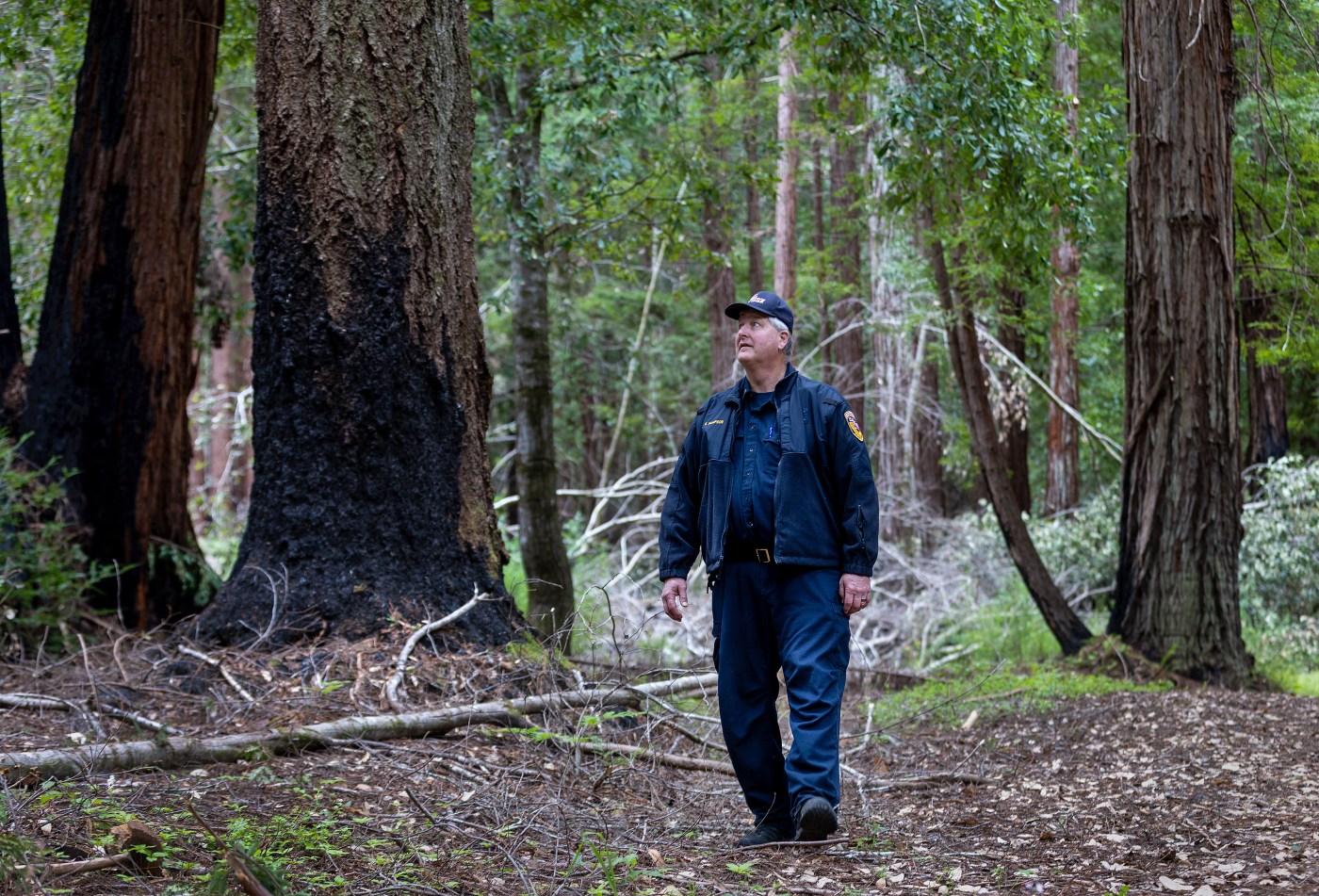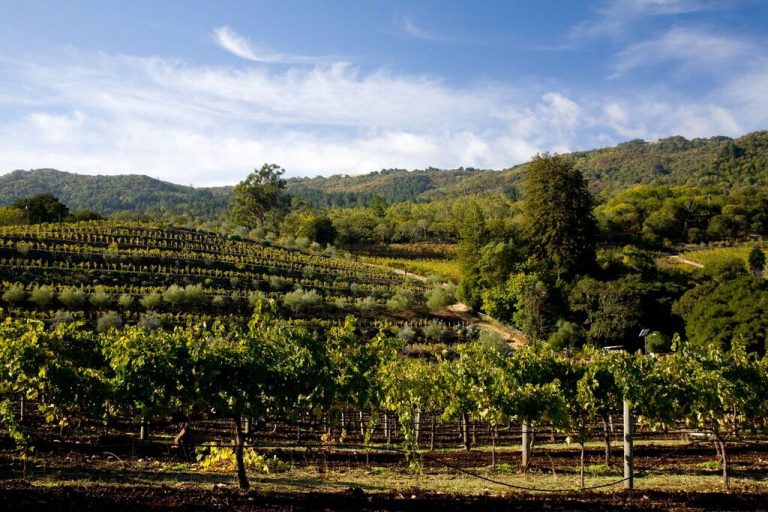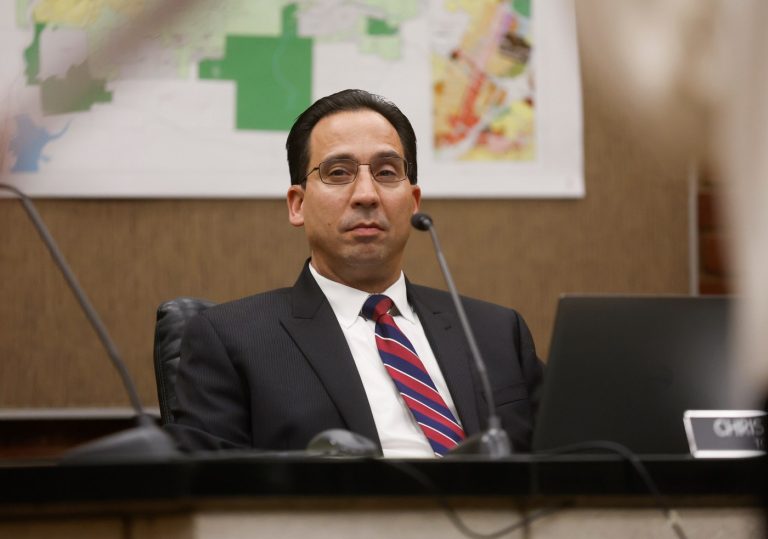It’s been nearly four years since the CZU Lightning Complex Fire raged through the Santa Cruz Mountains, destroying 911 homes, devastating Big Basin Redwoods State Park and blackening 86,500 acres — an area three times the size of San Francisco — in San Mateo and Santa Cruz counties.
But Carrie Herrera still vividly remembers how she felt as the massive flames appeared on a nearby ridge, threatening the camp she runs near La Honda.
“The smoke was horrendous,” she said. “You couldn’t even see in front of you. It was hard to breathe. Your jacket and hair were covered with ash. You smelled like a bonfire. It was very ominous.”
Smoke rises from the CZU August Lightning Complex fire burning behind Davenport, Calif., in a view from Pigeon Point, Friday morning, Aug. 21, 2020. (Karl Mondon/Bay Area News Group)
As the executive director of the YMCA’s Camp Jones Gulch, a beloved 928-acre wooded property that has hosted children since the 1930s, Herrera was overjoyed when the camp survived. Because of the COVID pandemic, there were no children there when the fire began in August 2020. In a normal year, there would have been more than 200 to evacuate as the inferno loomed.
Now she, along with local and state officials, are trying to reduce the risk of a similar threat. The camp, and Pescadero Creek County Park next door, will be the beneficiaries of a new $5.5 million state grant from the California Department of Forestry and Fire Protection aimed at thinning overgrown forests in the area, reducing fire risk, and improving habitat for wildlife.
The YMCA’s Camp Jones Gulch, a 928-acre property in the Santa Cruz Mountains located in La Honda on Wednesday, May 18, 2022. (Photo by YMCA)
Starting later this year and continuing until 2029, the project will thin 807 forested acres across both properties.
It’s all part of a larger, ongoing effort taking place across rural San Mateo and Santa Cruz counties to bring the forests back to a more natural condition following more than 100 years of fire suppression that left overgrown brush, dead and dying trees, and other conditions that make fires like the CZU burn much larger, hotter and deadlier than they historically would have.
The grants are included in a $153 million package that Cal Fire is rolling out this month to treat roughly 75,000 acres in the Sierra Nevada, around Lake Tahoe, on the slopes of Mount Tamalpais in Marin County, and other locations. The money will be used to reduce fire risk, improve wildlife habitat, and in some areas, restore landscapes that have already burned in recent fires.
Rich Sampson, a division chief with Cal Fire, said dry conditions made worse by climate change, coupled with unnaturally large amounts of vegetation, have placed many areas in California at high risk.
Cal Fire Division Chief Rich Sampson speaks at the YMCA Camp Jones Gulch property in La Honda, Calif., about upcoming plans for fire protection thinning, Thursday, April 25, 2024. Parts of the camp, near the scar of the 2020 CZU Fire, are scheduled for the work this summer. (Karl Mondon/Bay Area News Group)
Related Articles
PG&E profits hop higher, company raises already rosy outlook for 2024
Allstate will insure California homes again, under one condition
Climate change supercharged a heat dome, intensifying 2021 fire season, study finds
Firefighter, forester, trail builder: The first US Climate Corps jobs are here
Gov. Newsom announces first new state park in a decade and sets climate goals for natural lands
He remembers battling the CZU Lightning Fire, desperately short of firefighters, engines, helicopters and other equipment because there were dozens of other large fires burning at the same time in other parts of California.
“That fire blew up from 3,000 acres to 40,000 acres in a 12-hour period,” he said, pointing across wooded hillsides near the town of La Honda. “If we’d have had a major wind shift out of the south, it could have gone right over Highway 35, and burned down into Portola Valley and Palo Alto.”
Sampson said Cal Fire and other agencies have been coordinating projects from the Devil’s Slide area in northern San Mateo County all the way south to the Monterey County line in recent years. There are roughly 40 such “forest health” projects ongoing now across 28,000 acres in southern San Mateo County alone.
“We are trying to get this forest reset so we are ready for the next fire,” he said. “It’s a big job.”
As with the other projects, the work at the YMCA camp and Pescadero Creek County Park takes time. Wildlife and plant studies are required to be done first. Bird surveys must be completed. Planners use aerial photographs and GIS mapping software to ensure that crews leave a mix of differently aged trees, of different species, from oaks to redwoods to madrones and Douglas firs. They work in the summer and fall months, out of the rainy season.
“We have denied forests fire for more than 100 years, and the result is denser forests,” said Timothy Federal, forest health manager for the San Mateo Resource Conservation District, which is coordinating the YMCA and Pescadero park projects. “We are trying to set up the landscape in a beneficial way so that fires burn less severely.”
Federal said that much of the work will thin out dense brush. Crews also will take out invasive species like French broom. Much of the cutting will be in trees 8 inches in diameter or smaller. Dead and dying trees will be removed. After the thinning work is finished on the two properties, planners hope to conduct controlled burns there to further reduce fire risk.
Taking out the unnaturally overgrown “understory” of the forest, as biologists call it, has other benefits: It allows redwoods to more easily grow into old-growth giants, which provide habitat for animals like the marbeled murrelet, an endangered sea bird.
Also, by increasing the likelihood that wildfires will burn at a slow, moderate pace along the ground, instead of in an out-of-control rampage, crews hope to reduce the risk of erosion that can follow devastating blazes. Too much erosion in the rainy months after big fires can dump thousands of tons of dirt and silt into nearby streams, killing endangered coho salmon and other species.
Many of the forests in the Santa Cruz Mountains haven’t been in a pristine state since the Civil War. They were heavily logged generations ago, with the biggest, most resistant trees removed. Now, the state is playing a game of catch-up, trying to slowly steer them back toward a more natural condition.
“We’re not trying to get this forest back to where it was more than 100 years ago,” said Evan Cole, natural resources manager at San Mateo County Parks. “We’re thinking about where it will be in the future. We’re living in a changing world.”












